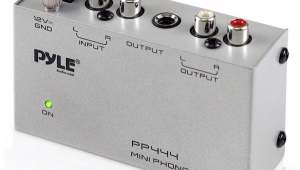Boulder 2008 phono preamplifier & 2010 preamplifier Page 2
That's outside. Inside is a very complex approach to phono-section design. While some designers try to rid their products of circuitry—like the ultra-pure-sounding "basic" Final Labs Music-4 phono section I covered in my January 2002 column—Boulder's founder and designer Jeff Nelson uses brute force, packing the 2008's dual-mono chassis with Boulder 993 gain-stage modules (for more detail, read their white paper), sealed relays, and a busy design that's the antithesis of the "simple, short signal path" advocated by some in the pursuit of analog purity and perfection.
A cynic might say, "If you're going to charge $29,000 for a phono section, you'd better pack it with stuff, but that doesn't necessarily have anything to do with good sound." That cynic would be so wrong.
Listening: Rockport's Antares speakers—400 lbs each and $41,500/pair—had been in my system for about a month when I sat down for my first listen to the Boulder 2008, so I'd become accustomed to and quite familiar with their performance using my reference system. The Antares is an impressive, full-range design. Driven by the Manley Steelhead phono stage, the Hovland HP-100 preamplifier, and the Musical Fidelity Nu-Vista 300 power amp, their sonic picture was big, full-bodied, and just plain tactile. No pain, but plenty of gain!
So it was with much skepticism that I substituted the 2008 for the Steelhead. I'll spare you a list of some of the well-known audio pros who've bought Steelheads. They hear what I hear: stupendous bass dynamics, transparency, purity, quiet, and on and on. It's a major accomplishment.
So is the Zanden 1200 ($15,000), which I previewed in my April 2002 column. A mono CD-R I made using the 1200 to record pre-RIAA mono LPs stopped some listeners in their tracks at CES 2002. The Zanden's midrange purity and resolution of harmonic structure couldn't be beat.
That's what I was thinking as I dropped the stylus in the groove for my first listen to the Boulder 2008. Would it be brighter, tighter, faster, "etchier," more transparent, better organized, more lush? I tried to imagine what the 2008 could possibly deliver to better the Steelhead and Zanden. One was more analytical, one was lusher, and both were incredibly accomplished—enough so that, between them, they seemed to cover all the sonic bases at the very highest level of analog reproduction. And the Pass Xono wasn't far behind, if at all, depending on your preferences.
Unfortunately, my imagination could not prepare me for what the 2008 delivered. I don't remember the first LP I played, but within a minute of listening I was no longer concerned with the sound of the music. What the 2008 delivered was the music's meaning. That's what you get for $29,000: communication—a direct connection to the intentions of the musicians. That may sound pretentious, but it's what I experienced in those first few hours of listening, with every genre of music.
Pulling out and spinning reference LPs, I was hit with all the familiar riffs—but now the musical lines made complete sense, as if they never had before. In many ways, they hadn't; despite repeated listening, the music had never been communicated to me like this: as musical lines carved in granite. What the Rockport turntable did mechanically the Boulder did electronically. This was an experience to be savored—there'd be plenty of time later to take it apart and analyze it. So I just listened and listened, muttering astonished expletives as I went. It was a mind-expanding evening.
I put on a record I've heard hundreds of times: Gershwin's Rhapsody in Blue, performed by Earl Wild, Arthur Fiedler, and the Boston Symphony (RCA Living Stereo LSC-2367). The overall "rightness" of the presentation in time and space floored me. Yes, Wild's piano was out front and firmly focused, but I'd heard that before, if maybe not quite so well-developed. What really stood out for me was one festive interlude with a driving salsa feel—I'd never heard it sound so tropical before. I'm no musicologist, and I've never read an analysis of Rhapsody in Blue, but I'd be very surprised if the jazz Gershwin injected into that section wasn't Cuban. Maybe I should have known that—but until the Boulder hit me over the head with it, I hadn't. If the point of having a really fine sound system is to communicate the music over the sound, the 2008 was a complete success.
I dragged my wife downstairs and, without prepping her about what she might hear, played her the 180gm LP of Alison Krauss and Union Station's New Favorite (Diverse DIV001LP), recorded in DSD and cut from the DSD master. She'd never heard it before in any form, but she'd heard the system minus the Boulder. First came a few dozen "Wow!"s that first expressed shock at the fundamental newness of the experience, then confirmed what I'd heard: "It's as if every note is the most important note ever played by anyone."
- Log in or register to post comments

















































